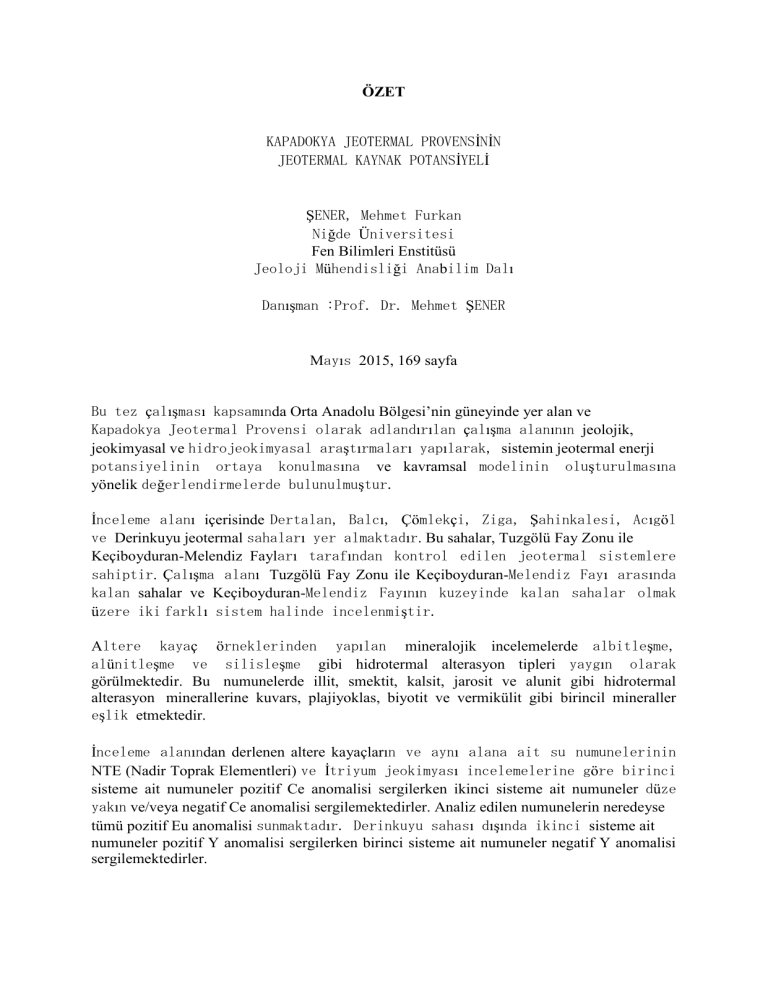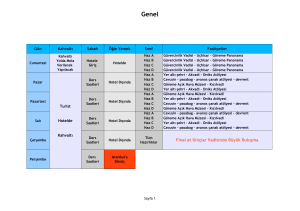
ÖZET
KAPADOKYA JEOTERMAL PROVENSİNİN
JEOTERMAL KAYNAK POTANSİYELİ
ŞENER, Mehmet Furkan
Niğde Üniversitesi
Fen Bilimleri Enstitüsü
Jeoloji Mühendisliği Anabilim Dalı
Danışman :Prof. Dr. Mehmet ŞENER
Mayıs 2015, 169 sayfa
Bu tez çalışması kapsamında Orta Anadolu Bölgesi’nin güneyinde yer alan ve
Kapadokya Jeotermal Provensi olarak adlandırılan çalışma alanının jeolojik,
jeokimyasal ve hidrojeokimyasal araştırmaları yapılarak, sistemin jeotermal enerji
potansiyelinin ortaya konulmasına ve kavramsal modelinin oluşturulmasına
yönelik değerlendirmelerde bulunulmuştur.
İnceleme alanı içerisinde Dertalan, Balcı, Çömlekçi, Ziga, Şahinkalesi, Acıgöl
ve Derinkuyu jeotermal sahaları yer almaktadır. Bu sahalar, Tuzgölü Fay Zonu ile
Keçiboyduran-Melendiz Fayları tarafından kontrol edilen jeotermal sistemlere
sahiptir. Çalışma alanı Tuzgölü Fay Zonu ile Keçiboyduran-Melendiz Fayı arasında
kalan sahalar ve Keçiboyduran-Melendiz Fayının kuzeyinde kalan sahalar olmak
üzere iki farklı sistem halinde incelenmiştir.
Altere kayaç örneklerinden yapılan mineralojik incelemelerde albitleşme,
alünitleşme ve silisleşme gibi hidrotermal alterasyon tipleri yaygın olarak
görülmektedir. Bu numunelerde illit, smektit, kalsit, jarosit ve alunit gibi hidrotermal
alterasyon minerallerine kuvars, plajiyoklas, biyotit ve vermikülit gibi birincil mineraller
eşlik etmektedir.
İnceleme alanından derlenen altere kayaçların ve aynı alana ait su numunelerinin
NTE (Nadir Toprak Elementleri) ve İtriyum jeokimyası incelemelerine göre birinci
sisteme ait numuneler pozitif Ce anomalisi sergilerken ikinci sisteme ait numuneler düze
yakın ve/veya negatif Ce anomalisi sergilemektedirler. Analiz edilen numunelerin neredeyse
tümü pozitif Eu anomalisi sunmaktadır. Derinkuyu sahası dışında ikinci sisteme ait
numuneler pozitif Y anomalisi sergilerken birinci sisteme ait numuneler negatif Y anomalisi
sergilemektedirler.
Çalışma alanına ait su örneklerinin kimyasal ve izotop analiz sonuçlarına
göre, her iki alandaki soğuk sular Ca-Mg-HCO3 ve Ca-HCO3 tipinde mineralce
fakir sulardır. Ancak sıcak sulardan birinci alan içerisindeki sıcak sular
Ca-Na-SO4 ve Ca-Mg-SO4 iken ikinci alanda bulunan sıcak sular ise Na-Cl-HCO3 ve
Ca-Na-HCO3 tipinde mineralce fakir sıcak sulardır. İzotop hidrolojisi
çalışmalarına
göre
çalışma
alanındaki
sular
meteorik
sulardan
beslenmektedirler.
Silis
jeotermometre
sonuçlarına
göre
Dertalan,
Melendizdağ, Keçiboyduran Dağı, Hasandağ (Keçikalesi), Ziga, Acıgöl ve
Derinkuyu sahaları sırasıyla 150-173 oC, 88-117 oC, 91-120 oC, 94-122 oC, 131-156 oC,
157-179 oC; 152-174 oC ve 102-130 oC arasında değişmektedir.
Jeolojik, jeokimyasal ve jeofizik verilerin birlikte değerlendirilmesi ile
oluşturulan Kapadokya Jeotermal Provensine ait kavramsal jeotermal modele göre;
alandaki jeotermal kaynaklar birincil ve ikincil tektonik kuşaklar tarafından
kontrol edilmektedir. Ayrıca, Paleozoyik-Mesozoyik yaşlı mermer ve gnayslar
sistemin hazne kayasını, Geç Kretase yaşlı gabro/granodiyorit sokulumları ile
bölgesel tektonik sonucu gelişen muhtemel bir kabuk incelmesi ile yüzeye
yaklaşan ısı akıları sistemin ısı kaynağını ve Kapadokya volkanitlerine ait tüf ile
ignimbiritlerde sistemin örtü kayasını oluşturmaktadır.
Tüm bu çalışmalara göre, alanda önemli bir jeotermal potansiyel bulunduğu görülmektedir.
Çalışma alanında bulunan jeotermal sistemin rezervuar veya hazne kayası ile örtü
kayasında herhangi bir sorun bulunmamakta, sistemde jeotermal akışkan
problemi bulunmaktadır.
Anahtar Sözcükler: OAVK/OAKK, Kapadokya, jeotermal sistemler, jeokimya, hidrotermal alterasyon,
kavramsal model.
SUMMARY
GEOTHERMAL RESOURCE POTENTIAL OF
CAPPADOCIA GEOTHERMAL PROVINCE
ŞENER, Mehmet Furkan
Niğde University
Graduate School of Natural and Applied Sciences
Department of Geological Engineering
Supervisor : Prof. Dr. Mehmet ŞENER
May 2015, 169 pages
Within the scope of this thesis, the geothermal potential of the system has been introduced
and conceptual model has been established with geological, geochemical and
hydrogeochemical research in the area named as Cappadocia Geothermal Province in the
south of Central Anatolia.
Dertalan, Balcı, Çömlekçi, Ziga, Şahinkalesi, Acıgöl and Derinkuyu
geothermal fields are located in the field area. These areas, which are controlled by
Keçiboyduran- Melendiz fault and Tuzgölü Fault Zone have geothermal systems. These areas,
which are controlled by Keçiboyduran-Melendiz fault and Tuzgölü Fault Zone have
geothermal systems.
Hydrothermal alteration types such as albitization, alunitization and silicification are widely
observed in mineralogical investigation of altered samples. Beside this, primary minerals such
as quartz, plagioclase, biotite and vermiculite are accompanied to hydrothermal alteration
minerals such as illite, smectite, calcite, jarosite and alunite in petrographic examinations.
According to REY (Rare Earth Elements and Yttrium) geochemistry of altered rock samples
and water samples which are belonging to the same location, the first system of rocks exhibit
positive Ce anomaly, as the second group of rocks show negative and/or close to the flat Ce
anomaly. Almost all of examined altered samples offer positive Eu anomalies. While the
second system of rocks except Derinkuyu exhibit positive Y anomaly, the first group of rocks
exhibit negative Y anomaly.
According to water chemistry and isotope analysis, the cold waters of both area groups are
Ca-Mg-HCO3 ve Ca-HCO3 type mineral poor waters but the hot waters of first group are CaNa-SO4 and Ca-Mg-SO4 type and the hot waters of second group are Na- Cl-HCO3 and Ca-
Na-HCO3 type of mineral poor hot waters. According to isotope hydrology studies, the
geothermal waters are fed from meteoric waters and according to the results of silica
geothermometer, the reservoir temperature of Dertalan, Melendiz Mount, Keçiboyduran
Mount, Hasan Mount (Keçikalesi), Ziga, Acıgöl, and Derinkuyu geothermal waters
are 88-150-173 oC, 88-117 oC, 91-120 oC, 94-122 oC, 131-156 oC, 157-179 oC; 152-174 oC
and 102-130 oC, respectively.
According to the conceptual geothermal model of Cappadocia Geothermal Province which is
generated after geological, geochemical and geophysical data; the geothermal resources in the
field area are controlled by primary and secondary tectonic belts. Also, according to this
conceptual geothermal model, Paleozoic-Mesozoic marble and gneiss constitutes the reservoir
rock. Late Cretaceous intrusions of granodiorite/gabbro and impending heat fluxes to the
surface with a possible crustal thinning which developed after regional tectonism results
constitutes the heat sources. Miocene-Pliocene and tuff and ignimbrites of Quaternary
Cappadocia Volcanics also constitute the seal rock of the geothermal system.
As a result of all these studies, Cappadocia has a significant geothermal potential. There are
no problems of reservoir or seal rock in the study area, but geothermal fluid of the system is
problematic.
Keywords: CAVP/CACC, Cappadocia, geothermal systems, geochemistry, hydrothermal alteration,
conceptual model.

